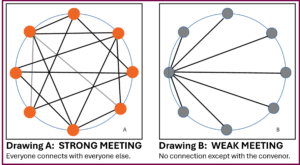A Good Convenor Empowers the Group
In a healthy LifeRing meeting, there is broad participation and engaging conversation, involving practically everyone at some point during the meeting. The convenor’s distinct responsibility is to facilitate and protect the sober connections of all members with each other. When the convenor has laid the foundation properly, meeting members can engage in "sober-sober communication" with one another throughout the meeting.
 The meeting is not about the convenor. The meeting is about encouraging sober connections within the group, so that the participants themselves become connected and empowered. In an established LifeRing meeting where everyone is familiar with the format, the convenor may be almost invisible. It's only when there is a snag in the meeting's process that you may discover who the convenor is. The key difference between a convenor's role and that of a member is the focus of the convenor is on the needs of others.
The meeting is not about the convenor. The meeting is about encouraging sober connections within the group, so that the participants themselves become connected and empowered. In an established LifeRing meeting where everyone is familiar with the format, the convenor may be almost invisible. It's only when there is a snag in the meeting's process that you may discover who the convenor is. The key difference between a convenor's role and that of a member is the focus of the convenor is on the needs of others.
A strong meeting has connections between every participant, as shown in Drawing A in the diagram provided. A robust exchange of supportive engagement is the goal of a convenor. A weak meeting, on the other hand, is one where all communication only goes through the convenor, as in "Drawing B". This type of convenor acts more like a lecturer or guru, not a convenor.
The ultimate aim is to build a vibrant, interconnected community where every voice is heard and every member feels empowered, knowing that the strength of the group lies in the connections they forge with one another.
